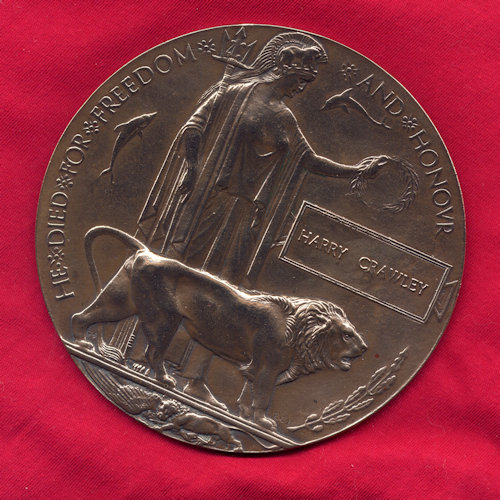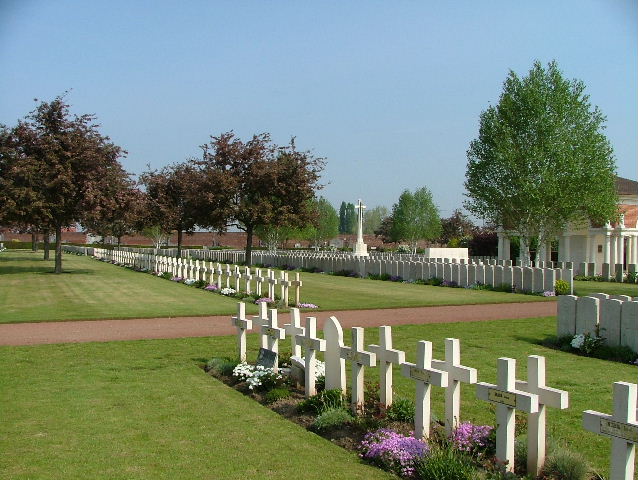Name
Harry Crawley
Conflict
First World War
Date of Death / Age
26/02/1917
35
Rank, Service Number & Service Details
Private
33153
Leicestershire Regiment
6th Bn.
Awards: Service Medals/Honour Awards
British War and Victory medals
Cemetery/Memorial: Name/Reference/Country
BETHUNE TOWN CEMETERY
VI. B. 75.
France
Headstone Inscription
Not Researched
UK & Other Memorials
Pirton Village War Memorial,
St Mary’s Shrine, Pirton,
Methodist Chapel Plaque, Pirton,
Pirton School Memorial
Biography
Harry was the son of an Offley man(*1), Henry Charles Crawley, and a Pirton woman, Minnie Cherry. They married some time around 1882. Henry worked as a farm labourer and then a horse keeper and by 1911 they had ten children(*2), although one had died. They lived at Middle Farm on Crabtree Lane roughly where 16 Crabtree Lane is today.
After leaving Pirton School, Harry followed in his father’s footsteps to become a horse-keeper. Probably, as the Parish Magazine report appearing here suggests, for Mr Thomas Franklin of Walnut Tree Farm.
When war came, Harry was still living with his mother in Middle Farm, his father had died some time between 1911 and 1915, and on December 9th 1915 he enlisted. His brother Frank also heard the ‘call to arms’ and followed him, some time between March 2nd and July 1916. Frank survived the war.
Although he joined the 5th Battalion of the Bedfordshire Regiment, he was transferred to the 6th Battalion of the Leicestershire Regiment at some point. They were another service battalion formed for the duration of the war and to train Lord Kitchener’s first wave of men raised for the war. They were ordered to France and landed on July 29th 1915, but Harry did not go to France until December 10th 1916 and it was on December 21st that he joined his new Battalion in the field.
They were at Auchel in northern France and out of the line, so Harry had a quiet start. The Battalion had Christmas dinner together, in the local theatre, and on New Year’s Eve the Battalion band played the old year out. On January 27th they were due to go back into the trenches, but that order was cancelled and instead they were ordered to move to the area round Hazebrouck. They marched to Lillers, caught a train to Proven in Belgium, about thirty miles to the north, and then marched the three miles to Houtkerque. This is about fifteen miles from Ypres and quite probably they were being held in reserve and despite their Commanding Officer reconnoitring the defences, they did not go into action. Instead, on February 14th they went back to France, first to Chocques and then to Bethune and by the 18th they were in the Lancashire trench at Noyelles. The war diary for the 22nd to the 25th describes their activity as ‘Normal trench warfare. One wounded on 23rd and died of wounds.’
That man was Private Harry Crawley and that is confirmed by his service record. As he was initially only wounded he was probably taken to a hospital near or in Bethune. The Commonwealth War Graves Commission notes that: ‘Bethune was comparatively free from bombardment and remained an important railway and hospital centre, as well as a corps and divisional headquarters. The 33rd Casualty Clearing Station was in the town until December 1917’. It is probably this clearing station where Harry was taken and just three days later on the 26th, only a little over two months after he first joined the Battalion, he died.
The Hertfordshire Express newspaper of March 10th 1917, under the heading ‘3rd Year of War, 32nd Week’ and, referring to local men, lists 4 men killed, 2 men died of wounds, 1 man missing and 8 wounded. Under ‘Killed’ is ‘Private Harry Crawley, Pirton’.
As the name suggests, Bethune Town Cemetery serves the town. The war graves lie in a large separate area holding 3,004 Commonwealth burials from the Great War, including Indian soldiers. It also contains some French burials and, interestingly, some German graves – probably all these men died in the hospital.
It is formally laid out, as one might expect, with large areas of grass and the soldiers are carefully grouped in their various nationalities. The Great Cross sits behind the large War Shrine, rising above and encouraging eyes upwards, but the War Shrine carries the important message and reminds visitors that ‘THEIR NAME LIVETH FOR EVERMORE’.
His few remaining effects were returned to his mother, who recorded their receipt on May 4th 1917 and three years later on October 9th 1920 she received his Memorial Scroll, bearing the signature of the King.
(*1) Although confusingly his birth place is given as Offley (1911 census), Ickleford (1901) and Kings Walden (1891).
(*2) Harry (b 1881 or 1882), Annie Jane (bapt 1885), Albert Vincent (b 1886), Florence Rose (b 1888), Alice (b 1891), Helen (b 1891), Millie Ellen or Eleanor? (b 1893), Katie or Kate (b 1895), Frank (b 1896) and Phillip (b 1902).
Additional Information
Text from the book: The Pride of Pirton
Acknowledgments
The Pride of Pirton book – www.pirton.org.uk/prideofpirton Chris Ryan / Tony French / Jonty Wild



